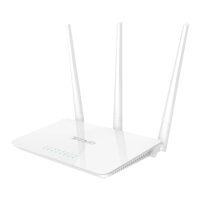3. SSID Broadcast: When it’s enabled, the wireless device will scan your Router’s SSID; when it’s
disabled, your Router’s SSID is hidden and you cannot find it on the SSID list, in which case you
need to enter the SSID manually for connecting to it.
4. AP Isolation: When it’s enabled, wireless devices connecting to your device cannot
communicate with each other.
5. Channel: Do not change the channel unless you experience interference (shown by lost wireless
connection or slow data transfers). If this happens, experiment with different channels to see which
the best is. The recommended channel spacing between adjacent access points is four channels (for
example, use channel 1 and 5, or 6 and 10).
6. Channel Bandwidth: Select any of these channel bandwidth options to accommodate higher
transmission speeds:
40: Select this bandwidth to maximize the wireless throughput.
20: Select this bandwidth if you encounter some issues with your wireless connection.
20/40 (default): Keep the default unless you encounter some issues with your wireless
connection.
7. Extension Channel: It’s used to determine the wireless frequency band of your Router. It can
only take effect in 11b/g/n mode when the channel bandwidth is “20/40”.
8. WMM Capable: It’s used to improve the wireless transmission performance. Suggest that you
keep this field Enable by default.
9. APSD Capable: It’s the time-saving mode, and can only take effect when WMM Capable is
enabled. Suggest that you keep the APSD Capable field is disabled by default.
Wireless Working Mode
When your router performs as a wireless router, the wireless working mode will be Wireless Access
Point (AP). However, when you want to use it as a repeater, you can select WDS Bridge Mode.

